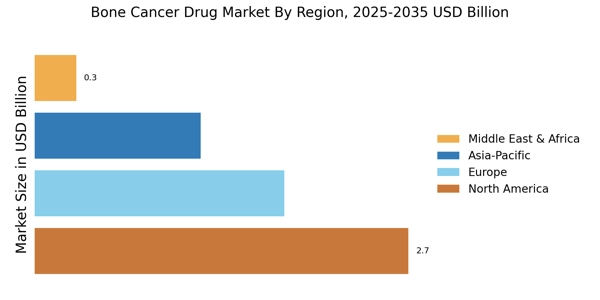Growing Incidence of Bone Cancer
The rising incidence of bone cancer is a primary driver for the Bone Cancer Drug Market. According to recent statistics, the prevalence of bone cancer has shown an upward trend, with an estimated 3.5 cases per 100,000 individuals annually. This increase in cases necessitates the development and availability of effective treatment options, thereby propelling the demand for innovative drugs. As healthcare systems strive to address this growing challenge, pharmaceutical companies are likely to invest more in research and development. This focus on creating targeted therapies and novel drug formulations is expected to enhance the treatment landscape for patients suffering from bone cancer, ultimately contributing to the expansion of the Bone Cancer Drug Market.
Rising Awareness and Early Diagnosis
The growing awareness surrounding bone cancer and its symptoms is positively impacting the Bone Cancer Drug Market. Educational campaigns and improved access to healthcare services have led to earlier diagnosis and treatment of bone cancer. As patients become more informed about the disease, they are more likely to seek medical attention promptly, which can lead to better treatment outcomes. This trend is reflected in the increasing number of patients receiving timely interventions, thereby driving the demand for effective bone cancer drugs. Consequently, the emphasis on early diagnosis and awareness initiatives is expected to play a pivotal role in shaping the future of the Bone Cancer Drug Market.
Increased Investment in Oncology Research
The surge in investment directed towards oncology research is a crucial factor propelling the Bone Cancer Drug Market. Governments and private entities are recognizing the urgent need to combat cancer, leading to increased funding for research initiatives. In recent years, funding for cancer research has reached unprecedented levels, with billions allocated to explore new treatment modalities. This financial support fosters innovation and encourages collaboration among researchers, healthcare providers, and pharmaceutical companies. As a result, the development of novel therapies for bone cancer is likely to accelerate, enhancing the treatment options available to patients and contributing to the overall growth of the Bone Cancer Drug Market.
Regulatory Support for Innovative Therapies
Regulatory bodies are increasingly providing support for the development of innovative therapies in the Bone Cancer Drug Market. Initiatives such as expedited review processes and orphan drug designations are encouraging pharmaceutical companies to invest in research for rare bone cancers. These regulatory incentives not only facilitate faster access to new treatments for patients but also stimulate competition among drug manufacturers. As a result, the market is likely to witness a proliferation of novel therapies aimed at addressing unmet medical needs in bone cancer treatment. This supportive regulatory environment is expected to significantly contribute to the growth and evolution of the Bone Cancer Drug Market.
Advancements in Drug Development Technologies
Technological advancements in drug development are significantly influencing the Bone Cancer Drug Market. Innovations such as high-throughput screening, artificial intelligence, and personalized medicine are streamlining the drug discovery process. These technologies enable researchers to identify potential drug candidates more efficiently and accurately, reducing the time and cost associated with bringing new therapies to market. For instance, the integration of AI in drug design has shown promise in predicting drug interactions and optimizing therapeutic efficacy. As a result, pharmaceutical companies are increasingly adopting these technologies, which may lead to a surge in the availability of effective bone cancer treatments, thereby driving growth in the Bone Cancer Drug Market.


















Leave a Comment